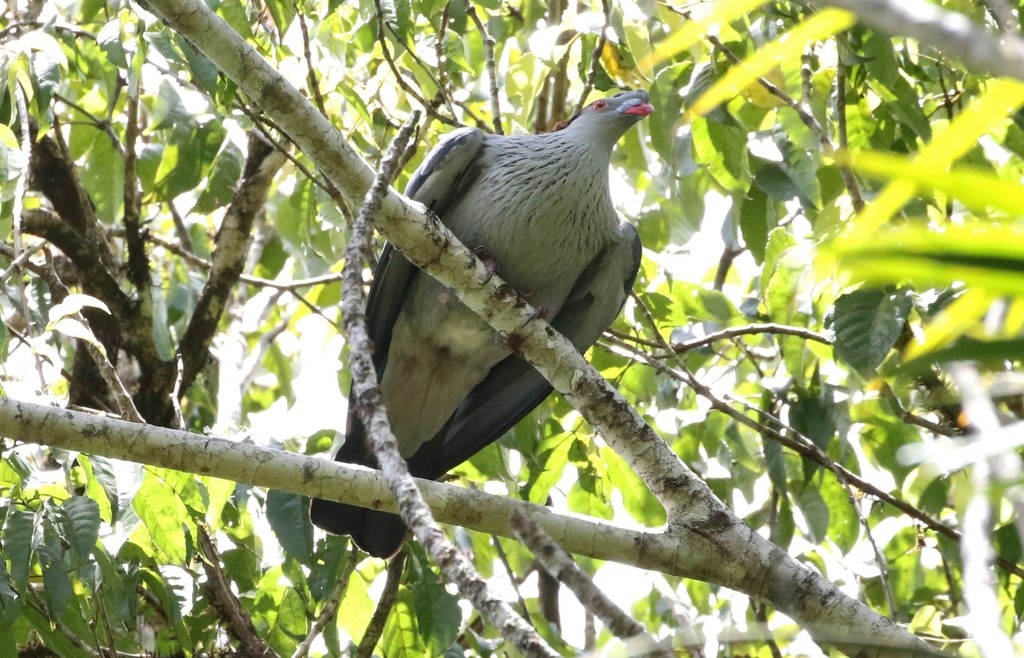Topknot Pigeon
A species of Topknot Pigeon Scientific name : Lopholaimus antarcticus Genus : Topknot Pigeon
Topknot Pigeon, A species of Topknot Pigeon
Botanical name: Lopholaimus antarcticus
Genus: Topknot Pigeon
Content
Description General Info
 Photo By silversea_starsong , used under CC-BY-NC-4.0 /Cropped and compressed from original
Photo By silversea_starsong , used under CC-BY-NC-4.0 /Cropped and compressed from original Description
The topknot pigeon is a large predominately slate-grey bird, measuring between 40 and 46 centimetres in length. The back, coverts and upper secondaries are a darker slate-grey with black quills. The primaries are black, the remaining body in a lighter slate-grey in colour. The chest and hind neck are notched, showing dark bases giving a streaked appearance , The tail is black crossed with a board grey band. The crest is grey from the cere to the forehead, and russet brown on the crown with black sides. The mandibles are red with a brown tip, the protuberances at the base of the mandibles are bluish-green. The tarsals and feet are purplish red. The sexes are similar in description. However, Males have larger crest and lack some of the streaking on the chest. Juveniles are like females but the chest is mottled not streaked, the crest is smaller, with the cere and forehead being light brown, the crown grey. Tarsals and feet are reddish brown. The iris is yellow-golden with a bright red outer band. In Fledglings the iris is brown. 
Size
45 cm
Nest Placement
Tree
Feeding Habits
Topknot Pigeon feasts primarily on various rainforest fruits, especially Ficus species, with a frugivorous diet that shifts with seasonal fruit ripening, facilitating seed dispersal through intact defecation. Topknot Pigeon forages in fruiting trees and lacks the grit-aided digestion common in its family.
Habitat
Topknot Pigeon typically inhabits a variety of forested environments, including tropical, subtropical, and temperate rainforests; closed, wet sclerophyll forests; and occasionally tall open sclerophyll forests and coastal Melaleuca forests. They are also seen in cleared agricultural areas. For nesting, topknot Pigeon prefers rainforest or adjacent drier forests and tends to roost in emergent canopy trees or tall trees situated on ridgetops. This species is highly mobile, often traversing vast distances in search of fruit-bearing trees across broad geographical regions.
Dite type
Omnivorous
General Info
Feeding Habits
Bird food type
Distribution Area
Found from Cape York Queensland to the central south coast of New South Wales. These pigeons cover great distances in search of fruit bearing trees suddenly appearing in areas where they have not been seen for many years and will occasionally move beyond their normal southern range limit, into eastern Victoria. Historic records from 1953 show the topknot pigeon as an "accidential" species to Tasmania with a specimen taken at Spreyton near Devonport. This bird was one of a flock of 9-10 birds feeding on cherries. Previous to this sighting, the only other recording was in 1907 when two specimens were taken near St. Helens, east coast of Tasmania. The Spreyton specimen is held in the Tasmania Museum, Collection Number 13184/B2703. 
Species Status
The species used to occur in enormous numbers in Australian rainforest, but the population declined because of forest clearance and shooting. Because of concern over the steep decline in their population, topknot pigeons now are a protected species in Australia. However the increasing prevalence of a new food source in the fruit of the 'weed' camphor laurel trees has seen a recent resurgence in their number. As populations appear to be fluctuating but large, the species is currently classified as Least concern by the IUCN. 
Scientific Classification
Phylum
Chordates Class
Birds Order
Pigeons and doves Family
Dove Genus
Topknot Pigeon Species
Topknot Pigeon